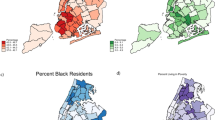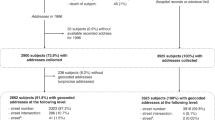Abstract
Background
There is a growing interest in the contextual effect of neighborhood linking social capital on different health outcomes, including cancer.
Aims
To examine associations between neighborhood linking social capital and incidence and mortality of prostate cancer.
Method
This cohort study was based on national registers. Between 2002 and 2015, we included 1,196,563 men aged 50 years and above in the analyses. Multilevel logistic regression was used to estimate odds ratios (ORs) and 95% confidence intervals (CI) for the association between exposure and outcome, adjusting for potential confounding factors.
Results
The total incidence of prostate cancer and mortality in patients with prostate cancer were 8.22 (per 100) and 1.80 (per 100), respectively, during the follow-up period. Individuals living in neighborhoods with low (OR 0.90; 95% CI 0.88–0.93) and intermediate (OR 0.94; 95% CI 0.92–0.96) linking social capital were less likely to be diagnosed with prostate cancer than those living in neighborhoods with high linking social capital. Opposite effects were observed for mortality; prostate cancer patients living in neighborhoods with low (OR 1.15; 95% CI 1.08–1.23) and intermediate (OR 1.09; 95% CI 1.03–1.14) linking social capital were more likely to die from prostate cancer than those in neighborhoods with high linking social capital.
Conclusions
Lower neighborhood linking social capital was associated with lower incidence but higher mortality in patients with prostate cancer. These findings suggest that men living in neighborhoods with low linking social capital may need additional surveillance for prostate cancer.
Similar content being viewed by others
Data availability
The data used in the present study cannot be shared as it is based on data obtained from Swedish population-based registers with national coverage.
References
Bray F, Ferlay J, Soerjomataram I, Siegel RL, Torre LA, Jemal A (2018) Global cancer statistics 2018: GLOBOCAN estimates of incidence and mortality worldwide for 36 cancers in 185 countries. CA Cancer J Clin 68:394–424
Rawla P (2019) Epidemiology of prostate cancer. World J Oncol 10:63–89
Cao Y, Ma J (2011) Body mass index, prostate cancer-specific mortality, and biochemical recurrence: a systematic review and meta-analysis. Cancer Prev Res (Phila) 4:486–501
Aune D, Navarro Rosenblatt DA, Chan DS, Vieira AR, Vieira R, Greenwood DC, Vatten LJ, Norat T (2015) Dairy products, calcium, and prostate cancer risk: a systematic review and meta-analysis of cohort studies. Am J Clin Nutr 101:87–117
Friedenreich CM, Neilson HK, Lynch BM (2010) State of the epidemiological evidence on physical activity and cancer prevention. Eur J Cancer 46:2593–2604
DeRouen MC, Schupp CW, Yang J, Koo J, Hertz A, Shariff-Marco S, Cockburn M, Nelson DO, Ingles SA, Cheng I, John EM, Gomez SL (2018) Impact of individual and neighborhood factors on socioeconomic disparities in localized and advanced prostate cancer risk. Cancer Causes Control 29:951–966
DeRouen MC, Schupp CW, Koo J, Yang J, Hertz A, Shariff-Marco S, Cockburn M, Nelson DO, Ingles SA, John EM, Gomez SL (2018) Impact of individual and neighborhood factors on disparities in prostate cancer survival. Cancer Epidemiol 53:1–11
Kawachi I, Berkman LF (2014) Social capital, social cohesion, and health. In: Berkman LF, Kawachi I, Glymour MM (eds) Social epidemiology, 2nd edn. Oxford University Press, New York, pp 290–319
Putnam R (1993) Making democracy work. Princeton University Press, Princeton
Szreter S, Woolcock M (2004) Health by association? social capital, social theory, and the political economy of public health. Int J Epidemiol 33:650–667
Hamano T, Li X, Sundquist J, Sundquist K (2019) Neighborhood linking social capital as a predictor of lung cancer: a Swedish national cohort study. Cancer Epidemiol 61:23–29
Sundquist K, Hamano T, Li X, Kawakami N, Shiwaku K, Sundquist J (2014) Linking social capital and mortality in the elderly: a Swedish national cohort study. Exp Gerontol 55:29–36
Murayama H, Fujiwara Y, Kawachi I (2012) Social capital and health: a review of prospective multilevel studies. J Epidemiol 22:179–187
Carrillo-Álvarez E, Kawachi I, Riera-Romaní J (2019) Neighbourhood social capital and obesity: a systematic review of the literature. Obes Rev 20:119–141
Kawachi I (2006) Commentary: social capital and health: making the connections one step at a time. Int J Epidemiol 35:989–993
Ehsana A, Klaas HS, Bastianen A, Spini D (2019) Social capital and health: a systematic review of systematic reviews. SSM Popul Health 8:100425
Sundquist J, Johansson SE, Yang M, Sundquist K (2006) Low linking social capital as a predictor of coronary heart disease in Sweden: a cohort study of 2.8 million people. Soc Sci Med 62:954–963
Sundquist J, Hamano T, Li X, Kawakami N, Shiwaku K, Sundquist K (2014) Neighborhood linking social capital as a predictor of psychiatric medication prescription in the elderly: a Swedish national cohort study. J Psychiatr Res 55:44–51
Sundquist K, Yang M (2007) Linking social capital and self-rated health: a multilevel analysis of 11,175 men and women in Sweden. Health Place 13:324–334
Callas PW, Pastides H, Hosmer DW (1998) Empirical comparisons of proportional hazards, poisson, and logistic regression modeling of occupational cohort data. Am J Ind Med 33:33–47
Snijders T, Bosker R (1999) Multilevel analysis: an introduction to basic and advanced multilevel modeling. SAGE Publications Inc., Thousand Oaks
Shelton RC, Gage-Bouchard EA, Jandorf L, Sriphanlop P, Thelemaque LD, Erwin DO (2016) Examining Social capital and its relation to breast and cervical cancer screening among underserved Latinas in the U.S. J Health Care Poor Underserved 27:1794–1811
Bender AM, Kawachi I, Jørgensen T, Pisinger C (2015) Neighborhood social capital is associated with participation in health checks of a general population: a multilevel analysis of a population-based lifestyle intervention- the Inter99 study. BMC Public Health 15:694
Sampson RJ, Raudenbush SW, Earls F (1997) Neighborhoods and violent crime: a multilevel study of collective efficacy. Science 64:918–924
Mihor A, Tomsic S, Zagar T, Lokar K, Zadnik V (2020) Socioeconomic inequalities in cancer incidence in Europe: a comprehensive review of population-based epidemiological studies. Radiol Oncol 54:1–13
Openshaw S (1983) The modifiable areal unit problem. Geo Books, Norwick
Funding
This research was supported by KAKENHI (Grant Number: 18K11143 to Tsuyoshi Hamano). This work was also supported by the Swedish Research Council to Kristina Sundquist. The funders had no role in the analysis, interpretation of data, or preparation of the manuscript.
Author information
Authors and Affiliations
Contributions
TH, XL, JS, KS worked on the conception of the study; XL performed the statistical analyses; TH, XL, JS, KS contributed to data interpretation; TH drafted the paper. All authors have read and approved the final manuscript.
Corresponding author
Ethics declarations
Conflict of interest
The authors have no confict of interest to disclose.
Ethical approval
This study was approved by the Regional Ethical Review Board in Lund.
Statement of human and animal rights
The study have been approved by the appropriate institutional research ethics committee and have been performed in accordance with the ethical standards as laid down in the 1964 Declaration of Helsinki and its later amendments or comparable ethical standards.
Informed consent
Participant consent was not obtained as the study was based on registry information.
Additional information
Publisher's Note
Springer Nature remains neutral with regard to jurisdictional claims in published maps and institutional affiliations.
Rights and permissions
About this article
Cite this article
Hamano, T., Li, X., Sundquist, J. et al. Neighborhood social capital and incidence and mortality of prostate cancer: a Swedish cohort study. Aging Clin Exp Res 33, 3333–3342 (2021). https://doi.org/10.1007/s40520-021-01852-9
Received:
Accepted:
Published:
Issue Date:
DOI: https://doi.org/10.1007/s40520-021-01852-9




